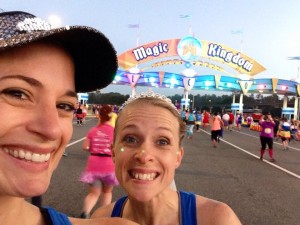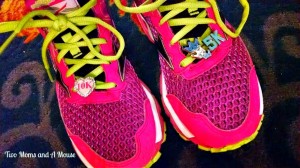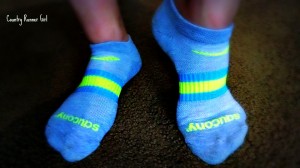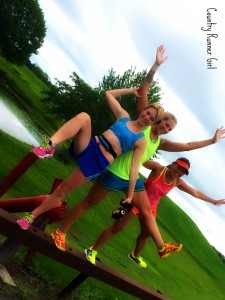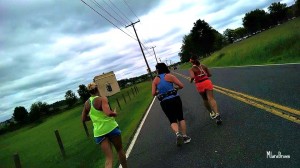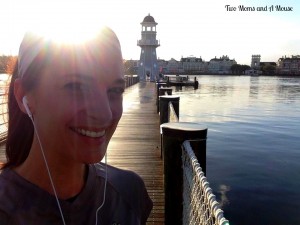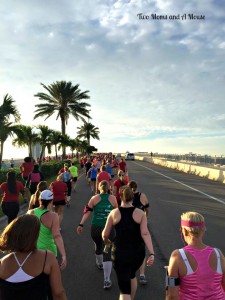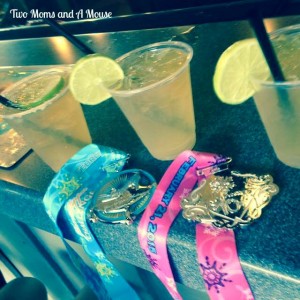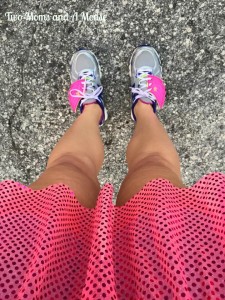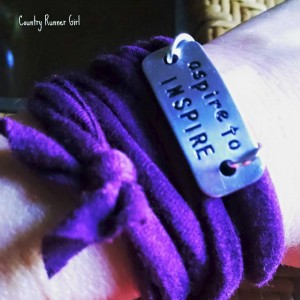When I started training to fulfill my obsession to run in the 2015 Princess Marathon Weekend in Walt Disney World, I had no idea this one obsession would turn into a much larger one. Running is addicting – period end of sentence. Be prepared when you decide to take your first dash out the door, it will probably be a life changing experience!
*** Check out our video montage from the 2015 Princess Marathon Weeknd Video Montage ***
In light of my new obsession I have learned quite a bit of information which has helped me to run stronger, quicker and safer. Here are the top ten principles of running that I have learned in my first year of becoming a runner.
- First things First –
The right running shoes can make or break your run, I think I changed mine 3 times before I settled into a pair. How do you know you have the right pair, by how your body feels overall after a run. Not wearing the proper running shoes for your feet will result in pain and lead to future injuries. Here is a guide to help better understand how to choose the best shoe for your best run. Learn Your Running Show Lingo
- Not only is the shoe important, so is the sock choice –
Going out for a quick 3- mile run may not require the most top notch, high tech pair of socks, but when you start running longer distances what you slip your feet into can mean the difference between gliding or limping across the finish line. Look for socks with the least amount of cotton; cotton holds all the moisture in and this will result in blisters amongst other complications. As you invest time in your run – you will need to invest more money into your socks. 9 Best Running Socks of 2014-2015
Now let’s talk about running stronger. Being a fairly new runner, I wasn’t concerned or even knowledgeable enough to be concerned about being a stronger runner. By pure accident I found the key to my stronger running success.
- Cross Training-
To be a stronger runner in endurance and speed and to help prevent injury it is important to find other forms of exercise outside of running. I have found using plyometrics has been an excellent method for me. During this past frigid New York winter, I searched for some form of indoor exercise since I was not able to tolerate the northern chill. I dialed into a plyometrics DVD and when spring sprung and I was ready to hit the pavement once again I felt explosive! My endurance and speed had increased! I ran faster, stronger and with more ease. I now make this part of my weekly routine, not only to strengthen my whole body and hopefully prevent any future injuries but to also help me be at the “top of my game” during races and long runs.
- Stretching –
“It’s a no brainer, of course I need to stretch before I take off into a sprint or a jog.”
Not so, I learned static stretching is not recommended prior to any kind of workout; it actually decreases your strength and endurance. It is better to warm up dynamically with jumping jacks, high kicks or stationary jogging with high knees. In some instances static stretching may be in order. If you have a reoccurring issue of tightness in a particular area of your body, such as, ham strings, calf muscles or like me, an iliotibial band, by all means stretch if this helps to prevent injury or pain during your run.
“The mind rules the body.” My mother has quoted this on several occasions for many different situations and I will say it reigns true with running.
- Running is certainly a sport of strength and stamina –
Where you place your thoughts will most certainly determine to what degree your strength and stamina will carry you through. Keep your mind focused on positive thoughts of success, a can do attitude. I have learned I am way more capable of achieving longer mileage and even faster mileage when I run with a clear mind and positive and uplifting thoughts – Heavy thoughts make for heavy legs.
- Set your mileage –
When you’re lacing up, set the mileage you want to accomplish that day in your head. Your mind will be focused on that goal and this will help you push through those more difficult miles and to keep on keeping on!
- Never say Never –
As I mentioned above, I have learned in my first year as a runner that I can achieve more than I thought possible. My initial goal was to run in the 2015 Princess Marathon Weekend with my friends and wear a tutu. Once I met that goal I realized I wanted more, my journey was not complete and it became ever changing and evolving. I will be running my first Half Marathon this weekend and in January 2016 I will be running in the WDW Marathon! Don’t set limitations on your journey, let it bring you to places that you never say never to. I promise it will be life changing!
- Find yourself a Running Buddy or Buddies –
When I first started running I was more than happy to tackle those miles alone. I welcomed the solitude and silence of being a solo runner. Once I hit 10 miles and more I needed the encouragement and comradery of another runner alongside of me. Even if we didn’t finish together as long as we started out together, it helped mentally and psychologically to get through those higher mileage goals. Nicole encouraged me to reach out on social media sites to find other runners. This was something I was not comfortable with so it took some additional encouragement from her before I followed thorough with that. But in doing so I have met and ran with some wonderful people! I encourage you to do the same. **Read here about the Power of the Group by Jeff Galloway – runner/author/coach
- So much information and so many opinions – my head is spinning! –
Everyone loves to share their opinions about sneakers, gear, fuel, run schedules; it can get a little overwhelming and confusing. In the beginning I kind of shut down to it all and just did whatever I felt like doing; this worked until about my 6 mile marker. There comes a time when it is important to start paying attention to the articles you read and other runners you talk to. Not all advice will be the best advice for you, figure out what works with the mileage your running what makes your body feel optimum during and after a run.
- Enjoy Yourself ~ #runfun
Running is hard work, from your very first run to the endless miles and races to come. Challenge yourself, push your limits, but don’t forget to have fun while doing it. Find a way to have fun with your run. Wear fun run clothing, find beautiful places to run, meet up with a group of people, register for races locally or places you have always wanted to visit ……. enjoy this journey of self-discovery you are on!
Country Runner Girl Photo Journal
- Celebrate your Successes – “TREAT YOURSELF!”
A celebration is in order when a goal is achieved or crossing a finish line in a race! Pop a bottle of champagne and make a toast to your successes! Buy that sparkle running skirt or that motivate wrap that you have been eying. As Nicole said it best with this video clip below ……
“TREAT YOURSELF!”
https://www.youtube.com/watch?v=OP3xf6BFEIo
Do you have a passion for running? Share with me something that you have learned either as a novice or an expert ~
Maureen~
by Olympian Jeff Galloway
Longer Long Runs
Increasing the length of the longest long run has produced the greatest amount of improvement that I’ve seen among my coaching clients. Several surveys have shown more than 13 minutes of time improvement when runners increase their longest long run from 20 miles to 26 miles before a marathon. Comparable time improvements are experienced in 10K runners and half marathoners when they increase their long runs above race distance as noted in my YEAR ROUND PLAN book that covers all the distances. Long runs must be at least 2 min/mi slower than current ability, with liberal walk breaks. The slower the pace, the quicker the recovery. I suggest doing the long runs every 2-3 weeks.
Speed Repetitions—increasing the number
My runners have improved by an average of over 6 minutes in a marathon (3+ minutes in a half marathon) by increasing the number of speed repetitions to 14 x 1 mile for the marathon, and 14 x 800 meter for the half marathon. I recommend that each of these be run 30 sec/mi faster than goal pace. The recovery interval is a 5 min walk between miles and a 3 minute walk between 800’s. These workouts prepare one to maintain or pick up pace at the end of the goal race, instead of slowing down. See GALLOWAY TRAINING PROGRAMS & HALF MARATHON books for details (www.RunInjuryFree.com).
Improve Running Form
Most runners I’ve monitored have improved several minutes in a marathon by fine-tuning their running form. As the mechanics become smoother and within one’s limits, there is a significant reduction in aches, pains and injuries. The two best ways to improve form are water running and cadence drills.
• water running uses the same basic motion as when running on land, using a flotation device so that the feet don’t touch the bottom of the pool. When done for at least 15 minutes, once a week, the legs find a more efficient path through the water—eliminating extraneous motion.
• The cadence drill is done for 30 seconds, counting the number of times the foot touches the ground. This drill is detailed in most of my books. I’ve found the key to improving speed on the mechanical side is quicker turnover.
Race in Shorter Events
Dropping down a standard distance or two can improve your mechanics for running faster and your ability to handle a higher level of oxygen debt. On non-long-run weekends, during a half marathon program, try some 5K or 10K races. When training for a marathon, race at the 10K or half marathon distance. At first, the faster pace of the shorter distance may seem awkward. But after several short races, you will adapt—especially if you do some speed training for the shorter/faster event. These performance improvements can translate into faster times in the longer distances. My book 5K/10K details the training and the racing strategies for these events.
Hill Training
The only way I’ve found to build strength for running is to run hill repeats. On a moderate grade hill, start at a jog and pick up the turnover rate of the feet and legs as you go up the hill, shortening your stride. Walk down the hill for recovery. Don’t sprint, and follow the other hill training guidelines in my books and at www.RunInjuryFree.com. The strength from hill training will allow you to perform better in speed sessions which will help you improve in your goal race. You’ll also run faster on hilly courses, during your races.

